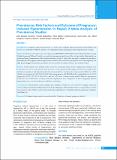Please use this identifier to cite or link to this item:
https://hdl.handle.net/20.500.14356/1093Full metadata record
| DC Field | Value | Language |
|---|---|---|
| dc.contributor.author | Shrestha, Dhan Bahadur | - |
| dc.contributor.author | Budhathoki, Pravash | - |
| dc.contributor.author | Malbul, Kiran | - |
| dc.contributor.author | Katwal, Srijana | - |
| dc.contributor.author | Jha, Saroj Kumar | - |
| dc.contributor.author | Prajapati, Roshni | - |
| dc.contributor.author | Srivastava, Ayushi | - |
| dc.contributor.author | Dangal, Ganesh | - |
| dc.contributor.author | Baral, Gehanath | - |
| dc.date.accessioned | 2023-04-23T10:44:10Z | - |
| dc.date.available | 2023-04-23T10:44:10Z | - |
| dc.date.issued | 2021 | - |
| dc.identifier.citation | ShresthaD. B., BudhathokiP., MalbulK., KatwalS., Jha S. K., PrajapatiR., SrivastavaA., DangalG., & BaralG. (2021). Prevalence, Risk Factors and Outcome of Pregnancyinduced Hypertension in Nepal: A Meta-Analysis of Prevalence Studies. Journal of Nepal Health Research Council, 19(2), 221-229. https://doi.org/10.33314/jnhrc.v19i2.3589 | en_US |
| dc.identifier.issn | Print ISSN: 1727-5482; Online ISSN: 1999-6217 | - |
| dc.identifier.uri | http://103.69.126.140:8080/handle/20.500.14356/1093 | - |
| dc.description | Review Article | en_US |
| dc.description.abstract | Abstract Background: Pregnancy induced hypertension is a major cause of global maternal mortality and morbidity. This review was conducted to fulfill the objective of evaluating the status of pregnancy induced hypertension in Nepal. Methods: The protocol for this review was registered in PROSPERO (CRD42020211210). Pubmed, Embase, Google Scholar, Scopus and Pubmed Central were searched using appropriate keywords for relevant studies. Data analysis was performed using Comprehensive Meta-Analysis Software version 3. Forest plot was used to visualize the prevalence and risk factors of Pregnancy induced hypertension. Random effect model was used and the level of heterogeneity was high. Joanna Briggins Institute bias assessment tool was used for the analysis of bias in the included studies. Results: Twenty studies were included in the review. The pooled prevalence of pre-eclampsia and eclampsia were 2.6% (95% CI, 1.2%-5.3%) and 0.5% (95% CI, 0.2%-1.1%) respectively. The majority of cases were young women and had not complete or unbooked antenatal visits. Cesarean delivery was the most common mode of deliveries in 50% of deliveries (proportion, 0.50; 95% CI, 0.40-0.60) among patients with PIH followed by vaginal deliveries in 43.1% (proportion, 0.431; 95% CI, 0.336-0.532); and rest 6.9% were vacuum/forceps assisted deliveries (proportion, 0.069; 95% CI, 0.050-0.093). Common maternal complications were abruption in 6.56% of Pregnancy induced hypertension cases, rest were pulmonary embolism, renal injury. Conclusions: The prevalence of pre-eclampsia and eclampsia in Nepal were 2.6% and 0.5%. Younger woman and women with poor antenatal checkups had increased risk of Pregnancy induced hypertension. Cesarean delivery was the most common route of delivery and common maternal complications were abruption placenta, pulmonary embolism, renal injury etc. Keywords: Eclampsia; hypertension; maternal mortality; Nepal; pre-eclampsia; pregnancy-induced | en_US |
| dc.language.iso | en | en_US |
| dc.publisher | Nepal Health Research Council | en_US |
| dc.relation.ispartofseries | Apr-June, 2021;3589 | - |
| dc.subject | Eclampsia | en_US |
| dc.subject | hypertension | en_US |
| dc.subject | maternal mortality | en_US |
| dc.subject | Nepal | en_US |
| dc.subject | pre-eclampsia | en_US |
| dc.subject | pregnancy-induced | en_US |
| dc.title | Prevalence, Risk Factors and Outcome of Pregnancyinduced Hypertension in Nepal: A Meta-Analysis of Prevalence Studies | en_US |
| dc.type | Journal Article | en_US |
| local.journal.category | Review Article | - |
| Appears in Collections: | Vol. 19 No. 2 (2021): Vol 19 No 2 Issue 51 Apr-Jun 2021 | |
Files in This Item:
| File | Description | Size | Format | |
|---|---|---|---|---|
| 3589-Manuscript-23755-1-10-20210907.pdf | Fulltext Download | 853.11 kB | Adobe PDF |  View/Open |
Items in DSpace are protected by copyright, with all rights reserved, unless otherwise indicated.
